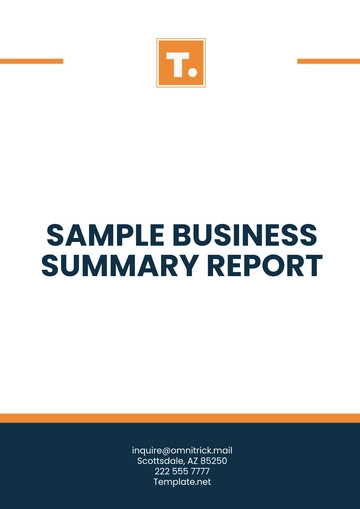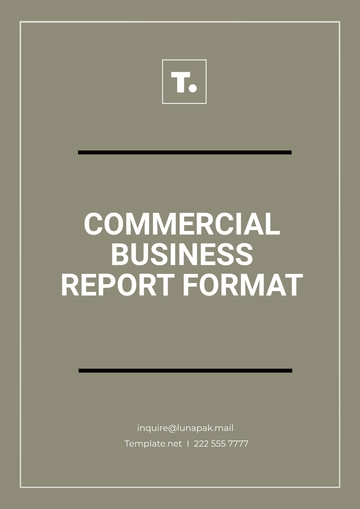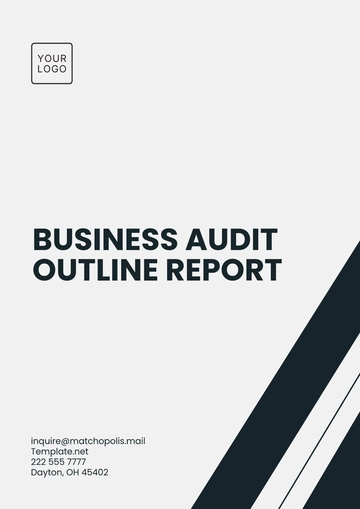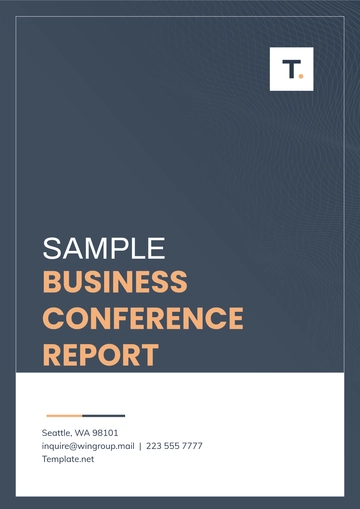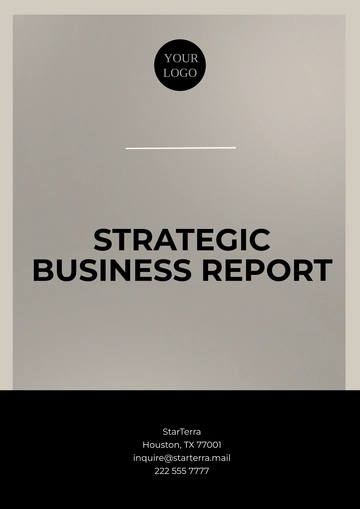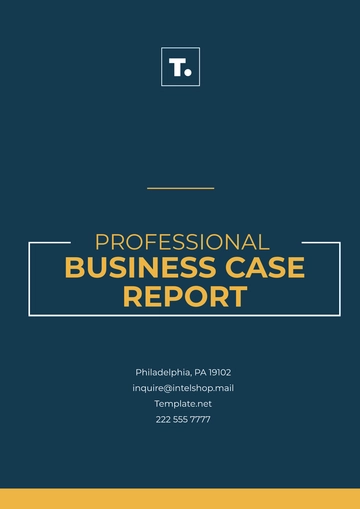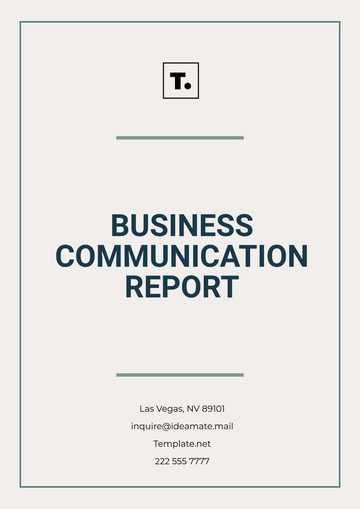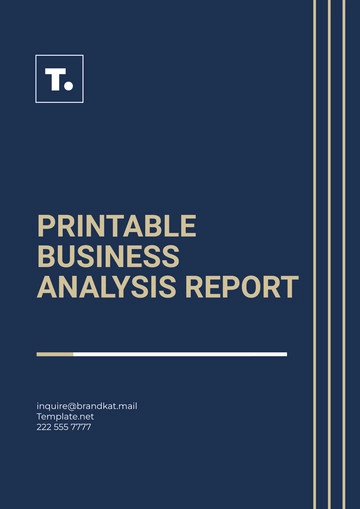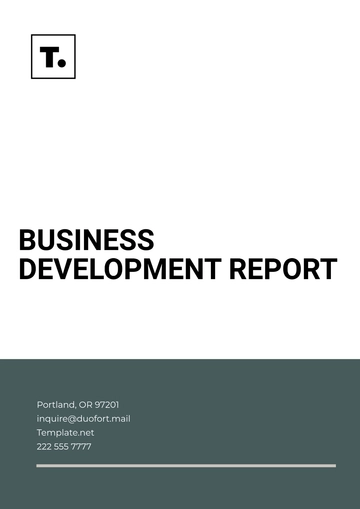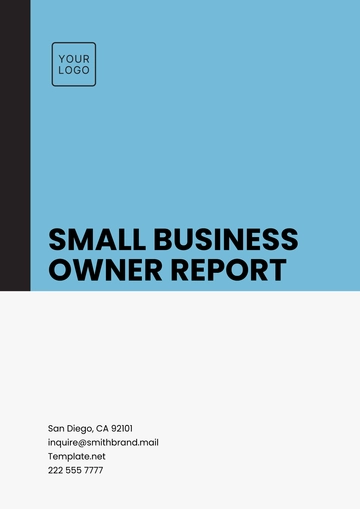Free Commercial Business Report Format

Prepared By | Company | Date Prepared |
|---|---|---|
[Your Name] | [Your Company Name] | [DATE] |
I. Executive Summary
Overview of the Report: A summary of the key findings, recommendations, and conclusions of the report.
Key Insights: High-level insights and highlights from the report's findings.
Recommendations: Summary of the proposed actions based on the report's conclusions.
II. Introduction
Purpose of the Report: Explanation of why the report was created, what it aims to address, and its relevance.
Scope of the Report: Details on the specific focus areas of the report, such as market analysis, financial performance, or operational review.
Target Audience: Identifies who the report is intended for (e.g., management, stakeholders, investors).
III. Methodology
Research Methods: Description of how the data was gathered (e.g., surveys, interviews, financial analysis).
Data Sources: List the sources used to collect data (e.g., internal company data, industry reports, third-party studies).
Analysis Techniques: Overview of the techniques used to analyze the data (e.g., statistical analysis, trend analysis).
IV. Findings/Results
Key Data Points: Present the core data or results of the analysis, such as sales trends, financial performance metrics, or market share.
Observations: Specific insights drawn from the data, highlighting significant trends, patterns, or anomalies.
Visuals: Charts, graphs, or tables to present the findings.
V. Discussion
Interpretation of Results: Analyze and interpret the findings, considering the implications for the business.
Challenges: Identify any challenges or limitations encountered during the research process or in the findings.
Impact: Discuss the potential impact of the findings on the business's operations, strategy, or financials.
VI. Conclusion
Summary of Key Points: Recap the most important findings and insights from the report.
Final Thoughts: Briefly discuss the overall implications for the business based on the findings and analysis.
VII. Recommendations
Proposed Actions: Offer specific, actionable recommendations for the business to address the issues or opportunities identified in the report.
Strategic Focus: Outline the strategic direction or focus areas that the business should pursue.
Implementation Plan: Suggest how to implement the recommendations, including timelines or resources required.
VIII. Appendices
Additional Data: Include any supplementary charts, graphs, or raw data referenced in the report.
References: List all sources or references used to compile the report (e.g., industry reports, academic articles).
Glossary of Terms: Define any technical terms or jargon used in the report for clarity.
- 100% Customizable, free editor
- Access 1 Million+ Templates, photo’s & graphics
- Download or share as a template
- Click and replace photos, graphics, text, backgrounds
- Resize, crop, AI write & more
- Access advanced editor
Create polished reports with the Commercial Business Report Format Template from Template.net. This customizable and editable template helps you professionally present commercial data and findings. Edit the layout and text in our AI Editor Tool to fit your specific business needs, making it an ideal choice for comprehensive commercial reporting.
You may also like
- Sales Report
- Daily Report
- Project Report
- Business Report
- Weekly Report
- Incident Report
- Annual Report
- Report Layout
- Report Design
- Progress Report
- Marketing Report
- Company Report
- Monthly Report
- Audit Report
- Status Report
- School Report
- Reports Hr
- Management Report
- Project Status Report
- Handover Report
- Health And Safety Report
- Restaurant Report
- Construction Report
- Research Report
- Evaluation Report
- Investigation Report
- Employee Report
- Advertising Report
- Weekly Status Report
- Project Management Report
- Finance Report
- Service Report
- Technical Report
- Meeting Report
- Quarterly Report
- Inspection Report
- Medical Report
- Test Report
- Summary Report
- Inventory Report
- Valuation Report
- Operations Report
- Payroll Report
- Training Report
- Job Report
- Case Report
- Performance Report
- Board Report
- Internal Audit Report
- Student Report
- Monthly Management Report
- Small Business Report
- Accident Report
- Call Center Report
- Activity Report
- IT and Software Report
- Internship Report
- Visit Report
- Product Report
- Book Report
- Property Report
- Recruitment Report
- University Report
- Event Report
- SEO Report
- Conference Report
- Narrative Report
- Nursing Home Report
- Preschool Report
- Call Report
- Customer Report
- Employee Incident Report
- Accomplishment Report
- Social Media Report
- Work From Home Report
- Security Report
- Damage Report
- Quality Report
- Internal Report
- Nurse Report
- Real Estate Report
- Hotel Report
- Equipment Report
- Credit Report
- Field Report
- Non Profit Report
- Maintenance Report
- News Report
- Survey Report
- Executive Report
- Law Firm Report
- Advertising Agency Report
- Interior Design Report
- Travel Agency Report
- Stock Report
- Salon Report
- Bug Report
- Workplace Report
- Action Report
- Investor Report
- Cleaning Services Report
- Consulting Report
- Freelancer Report
- Site Visit Report
- Trip Report
- Classroom Observation Report
- Vehicle Report
- Final Report
- Software Report

